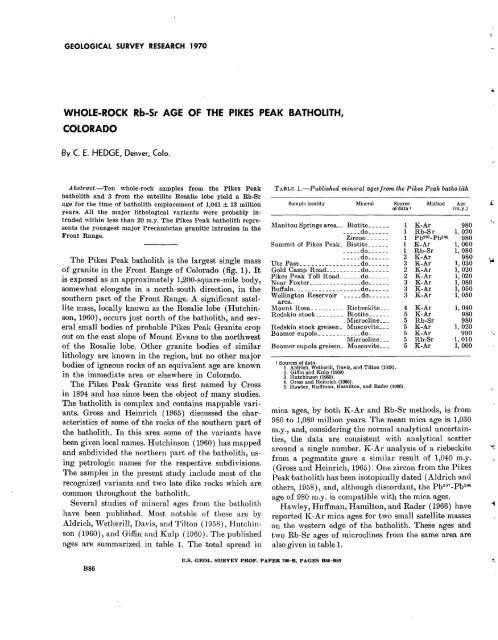RESEARCH· ·1970·
RESEARCH· ·1970·
RESEARCH· ·1970·
You also want an ePaper? Increase the reach of your titles
YUMPU automatically turns print PDFs into web optimized ePapers that Google loves.
GE,OLOGICAL SURVEY RESEA·RCH 1970<br />
WHOLE-ROCK Rb-Sr AGE OF THE PIKES PEAK BATHOLITH,<br />
COLORADO<br />
By C. E. HEDGE, Denver, Colo.<br />
A.bstract.-Ten whole-rock samples from the Pikes Peak<br />
batholith and 3 from the satellite Rosalie lobe yield a Rb-Sr<br />
age for the time of batholith emplacement of 1,041 ± 13 million<br />
years. All the major lithological variants were probably intruded<br />
within less than 20 m.y. The Pikes Peak batholith represents.<br />
the youngest major Precambrian granitic intrusion in the<br />
Front Range.<br />
The Pikes Peak batholith is the largest single mass<br />
of granite in the Front Range of Colorado (fig. 1). It<br />
is exposed as an approximately 1,200-square-mile body,<br />
somewhat elongate in a north-south direction, in the<br />
southern part of the Front Range. A significant satellite<br />
mass, locally known as the Rosalie lobe (Hutchinson,<br />
1960), occurs just north of the batholith, and several<br />
small bodies of probable Pikes Peak Granite crop<br />
out on the east slope of ~1ount Evans to the northwest<br />
of the Rosalie lobe. Other granite bodies of similar<br />
lithology are known in the region, but no other major<br />
bodies of igneous rocks of an equivalent age are known<br />
in the immediate area or elsewhere in Colorado.<br />
The Pikes Peak Granite was first named by Cross<br />
in 1894 and has since been the object of many studies.<br />
The batholith is complex and contains mappable variants.<br />
Gross and Heinrich ( 1965) discussed the characteristics<br />
of some of the rocks of the southern part of<br />
the batholith. In this area some of the variants have<br />
been given local names. IIutchinson (1960) has mapped<br />
and subdivided the northern part of the batholith, using<br />
petrologic names for the respective subdivisions.<br />
The samples in the present study include most of the<br />
recognized variants and two late dike rocks which are<br />
common throughout the batholith.<br />
Several studies of mineral ages from the batholith<br />
have been published. Most notable of these are by<br />
Aldrich, Wetherill, Davis, and Tilton ( 1958), Hutchinson<br />
(1960), and Giffin and l(ulp ( 1960). The published<br />
aJges rure summarized in truble 1. The total spread in<br />
TABLE I.-Published mineral ages from the Pikes Peak batholith<br />
Sample locality Mineral Source<br />
of data t<br />
Manitou Springs area __ Biotite _____ _____ do _____ _<br />
Zircon _____ _<br />
Summit of Pikes Peak_ Biotite _____ _____ do _____ _<br />
_____ do _____ _<br />
Ute Pass _________________ do _____ _<br />
Gold Camp Road __________ do ___ _, __<br />
Pikes Peak Toll Road ______ do _____ _<br />
Near Foxter _______________ do _____ _<br />
Buffalo ___________________ do _____ _<br />
Wellington Reservoir _____ do _____ _<br />
area.<br />
Mount Rosa _________ Riebeckite __ _<br />
Redskin stock ________ Biotite _____ _<br />
Microcline __ _<br />
Redskin stock greisen _ Muscovite __ _<br />
Boomer cupola ____________ do---_<br />
Microcline __ _<br />
Boomer cupola greisen_ Muscovite __ _<br />
1 Sources of data:<br />
1. Aldrich, Wetherill, Davis, and Tilton (1958).<br />
2. Giffin and Kulp (1969).<br />
3. Hutchinson (1960).<br />
4. Gross and Heinrich (1966).<br />
5. Hawley, Huffman, Hamilton, and Rader (1966).<br />
Method<br />
1 K-Ar<br />
1 Rb-Sr<br />
1 Pb2o7_pb206<br />
1 K-Ar<br />
1 Rb-Sr<br />
2 K-Ar<br />
2 K-Ar<br />
2 K-Ar<br />
2 K-Ar<br />
3 K-Ar<br />
3 K-Ar<br />
3 K-Ar<br />
4 K-Ar<br />
5 K-Ar<br />
5 Rb-Sr<br />
5 K-Ar<br />
5 K-Ar<br />
5 Rb-Sr<br />
5 K-Ar<br />
Age<br />
(m.y.)<br />
980<br />
1, 020<br />
980<br />
1,060<br />
1,080<br />
980<br />
1, 030<br />
1,020<br />
1, 020<br />
1, 080<br />
1, 050<br />
1, 050<br />
1, 040<br />
980<br />
980<br />
1, 020<br />
990<br />
1, 010<br />
1, 000<br />
mica ages, by both 1(-Ar and Rb-Sr methods, is from<br />
980 to 1,080 million years. The mea;n mioa ttge vs 1,030<br />
m.y., and, considering the normal analytical uncertainties,<br />
the data are consistent with analytical scatter<br />
around a single number. 1(-Ar analysis of a riebeckite<br />
from a pegmatite -gave a similar result of 1,040 m.y.<br />
(Gross and Heinrich, 1965) . One zircon from the Pikes<br />
Peak batholith has been isotopically dated (Aldrich and<br />
others, 1958), and, although discordant, the Pb 207 -Pb 200<br />
age of 980 m.y. is compatible with the 1nica ages.<br />
Hawley, Huffman, Hamilton, and Rader (19·66) have<br />
reported I(-Ar mica ages for two s1nall satellite masses<br />
on the western edge of the batholith. These ages and<br />
two Rb-Sr ages of microclines from the same area are<br />
also given in table 1.<br />
(,.<br />
B86<br />
U.S. GEOL. SURVEY PROF. PAPER 700-B, PAGES B86-B89
















